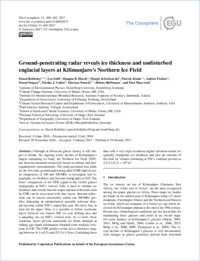Ground-penetrating radar reveals ice thickness and undisturbed englacial layers at Kilimanjaro’s Northern Ice Field
- Bohleber, Pascal Institute of Environmental Physics, Heidelberg University, Heidelberg, Germany - Climate Change Institute, University of Maine, Orono, ME, USA - Institute for Interdisciplinary Mountain Research, Austrian Academy of Sciences, Innsbruck, Austria
- Sold, Leo Department of Geosciences, University of Fribourg, Switzerland
- Hardy, Douglas R. Climate System Research Center and Department of Geosciences, University of Massachusetts Amherst, USA
- Schwikowski, Margit Paul Scherrer Institute, Villigen, Switzerland
- Klenk, Patrick Institute of Environmental Physics, Heidelberg University, Heidelberg, Germany
- Fischer, Andrea Institute for Interdisciplinary Mountain Research, Austrian Academy of Sciences, Innsbruck, Austria
- Sirguey, Pascal National School of Surveying, University of Otago, New Zealand
- Cullen, Nicolas J. Department of Geography, University of Otago, New Zealand
- Potocki, Mariusz Climate Change Institute, University of Maine, Orono, ME, USA - School of Earth and Climate Sciences, University of Maine, Orono, ME, USA
- Hoffmann, Helene Institute of Environmental Physics, Heidelberg University, Heidelberg, Germany
- Mayewski, Paul Climate Change Institute, University of Maine, Orono, ME, USA
-
09.02.2017
Published in:
- The Cryosphere. - 2017, vol. 11, no. 1, p. 469–482
English
Although its Holocene glacier history is still subject to debate, the ongoing iconic decline of Kilimanjaro's largest remaining ice body, the Northern Ice Field (NIF), has been documented extensively based on surface and photogrammetric measurements. The study presented here adds, for the first time, ground-penetrating radar (GPR) data at centre frequencies of 100 and 200 MHz to investigate bed topography, ice thickness and internal stratigraphy at NIF. The direct comparison of the GPR signal to the visible glacier stratigraphy at NIF's vertical walls is used to validate ice thickness and reveals that the major internal reflections seen by GPR can be associated with dust layers. Internal reflections can be traced consistently within our 200 MHz profiles, indicating an uninterrupted, spatially coherent internal layering within NIF's central flat area. We show that, at least for the upper 30 m, it is possible to follow isochrone layers between two former NIF ice core drilling sites and a sampling site on NIF's vertical wall. As a result, these isochrone layers provide constraints for future attempts at linking age– depth information obtained from multiple locations at NIF. The GPR profiles reveal an ice thickness ranging between (6.1 ± 0.5) and (53.5 ± 1.0) m. Combining these data with a very high resolution digital elevation model we spatially extrapolate ice thickness and give an estimate of the total ice volume remaining at NIF's southern portion as (12.0 ± 0.3) × 10⁶ m³.
- Faculty
- Faculté des sciences et de médecine
- Department
- Département de Géosciences
- Language
-
- English
- Classification
- Hydrology
- License
-
License undefined
- Identifiers
-
- RERO DOC 288668
- DOI 10.5194/tc-11-469-2017
- Persistent URL
- https://folia.unifr.ch/unifr/documents/305386
Other files
Statistics
Document views: 112
File downloads:
- pdf: 192
- Supplementary material: 162

